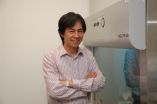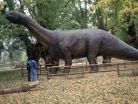(Press-News.org) LA JOLLA, Calif., March 12, 2012 – Children with multiple hereditary exostoses (MHE), an inherited genetic disease, suffer from multiple growths on their bones that cause pain and disfigurement. But beyond the physical symptoms of this condition, some parents have long observed that their children with MHE also experience autism-like social problems. Buoyed by the support of these parents, researchers at Sanford-Burnham Medical Research Institute (Sanford-Burnham) used a mouse model of MHE to investigate cognitive function. They found that mice with a genetic defect that models human MHE show symptoms that meet the three defining characteristics of autism: social impairment, language deficits, and repetitive behavior. The study, published online the week of March 12 in the Proceedings of the National Academy of Sciences USA, also defines the molecular and physiological basis of this behavior, pinpointing the amygdala as the region of the brain causing autistic symptoms.
"There is growing evidence that many autistic people have related genetic defects, or defects that are exacerbated by this one," said Yu Yamaguchi, M.D., Ph.D., professor in the Sanford Children's Health Research Center at Sanford-Burnham." Yamaguchi led this study, along with colleagues Fumitoshi Irie, Ph.D. and Hedieh Badie-Mahdavi, Ph.D.
Measuring social behavior in mice
In humans, MHE is caused by a mutation in one of two genes, Ext1 or Ext2. Together, these genes encode an enzyme necessary to produce heparan sulfate—a long sugar chain that helps bone cells grow and proliferate. In this study, Yamaguchi and his team used mice that lack the Ext1 gene in just a certain type of neuron to understand the mechanism of social problems in MHE patients.
Then the researchers examined the mice's behavior to test for the three defining characteristics of autism: social impairment, language deficits, and repetitive behavior. Using several different techniques, the team found that the mutant mice were less social than normal mice. They also exhibited language deficiencies, as determined using ultrasound vocalization measurements, a well-characterized substitute for mouse language. Lastly, Yamaguchi's team took at look at repetitive behaviors in these mice. Using a board covered with holes, they observed that normal mice will poke their noses in many holes at random, while the mutant mice poke their noses in the same hole again and again.
These behavioral measurements clearly demonstrate what the parents of children with MHE have always suspected—the disease affects more than just bones. The genetic defect that causes skeletal deformities also causes social and cognitive problems.
Pinpointing the amygdala
With these definitive simulations of autistic behavior in humans in hand, the researchers went on to define the cellular, molecular, and physiological basis for these symptoms. They did this first using a technique called c-Fos immuno-histochemistry, which illuminates the parts of the brain that are activated by certain experiences.
The researchers stimulated either normal or mutant mice with other normal mice for five minutes, then looked at their brains. In normal mice, the c-Fos immuno-histochemical staining lit up in the hippocampus, the amygdala, and other areas of the brain. In the mutant mice, the hippocampus was activated just as it was in normal mice. However, the amygdala of the mutant mice lacking the Ext1 gene wasn't nearly as activated as it was in normal mice. This finding pinpoints the amygdala as the region of the brain that contributes to autistic symptoms in this model.
"These results are consistent with the amygdala theory of autism," Yamaguchi said, referring to the idea that since the amygdala is thought to control a person's social intelligence, autism could be caused by abnormalities in that part of the brain.
What this means for the general autistic population
Obviously, not all autistic children have MHE, nor are all MHE children autistic. But, according to Yamaguchi, there is evidence that some people who are autistic might have similar defects in heparan sulfate. This is the sugar chain that's defective in MHE, where it causes bone deformities and—as this study now shows—social deficits.
"There are a few studies that compared the genomes of healthy and autistic people and they revealed differences in some heparan sulfate-related genes," Yamaguchi said.
There are most likely many different genetic abnormalities that can lead to autism in the general population. This study and others now indicate that for some (presumably a small percentage), the condition could be caused by mutations in genes encoding enzymes and proteins involved in making heparan sulfate.
There's even more evidence that heparan sulfate is an important factor in autism. According to Yamaguchi, several of the genes thought to be most closely associated with autism have an affinity for heparan sulfate. This means that while a slight reduction in heparan sulfate alone might not be the cause of many cases of autism, heparan sulfate defects could increase the severity of the disease when a person also has mutations in other autism candidate genes.
Yamaguchi's team is now comparing DNA from autistic and non-autistic volunteers to look for mutations in heparan sulfate genes. So far the initial results have been encouraging.
How patient advocates contributed to this research
Several years ago, Yamaguchi was studying bone development when he received a call from Sarah Zeigler, co-founder of the MHE Research Foundation. Zeigler's son, Robert, was born with MHE. Over the years, as Robert endured many surgeries to treat this incurable disease, Zeigler dug deep into the scientific literature to educate herself about MHE and bones. Somewhere along the way, she came across Yamaguchi's work and had a feeling that his research could impact MHE.
One of Zeigler's greatest frustrations was that most medical specialists only saw one part of Robert's disease, when she knew from her experience with him and other MHE patients that the disease affects more than just bones. These kids have social problems, too. She called Yamaguchi and told him all this, setting his research on a new course that led to this latest finding.
"I can't emphasize enough how much it helped that the parents of kids with MHE got involved and supported this research," Yamaguchi said. "As parents, they noticed their kids had social problems that gave them challenges at school. School officials and other people didn't take these observations seriously—they usually just waved off the problems, assuming that the kids' bone deformities just make them shy. This latest research doesn't solve any bone issues for MHE patients, but it does help support what the parents always knew—these children need special care."
INFORMATION:
This research was funded by the Eunice Kennedy Shriver National Institute of Child Health & Human Development at the National Institutes of Health, the Sanford Children's Health Research Center, the Mizutani Foundation, the MHE Research Foundation, and families of MHE patients.
About Sanford-Burnham Medical Research Institute
Sanford-Burnham Medical Research Institute is dedicated to discovering the fundamental molecular causes of disease and devising the innovative therapies of tomorrow. The Institute consistently ranks among the top five organizations worldwide for its scientific impact in the fields of biology and biochemistry (defined by citations per publication) and currently ranks third in the nation in NIH funding among all laboratory-based research institutes. Sanford-Burnham is a highly innovative organization, currently ranking second nationally among all organizations in capital efficiency of generating patents, defined by the number of patents issued per grant dollars awarded, according to government statistics.
Sanford-Burnham utilizes a unique, collaborative approach to medical research and has established major research programs in cancer, neurodegeneration, diabetes, and infectious, inflammatory, and childhood diseases. The Institute is especially known for its world-class capabilities in stem cell research and drug discovery technologies. Sanford-Burnham is a U.S.-based, non-profit public benefit corporation, with operations in San Diego (La Jolla) and Santa Barbara, California and Orlando (Lake Nona) in Florida. For more information, please visit our website or blog. You can also receive updates by following us on Facebook and Twitter.
Research on rare bone disorder reveals new insights into autism
Sanford-Burnham researchers discover the molecular basis of autistic symptoms in children with a rare bone disorder -- findings that also provide new insights for the general autistic population
2012-03-13
ELSE PRESS RELEASES FROM THIS DATE:
Smartphones more accurate, faster, cheaper for disease surveillance
2012-03-13
Smartphones are showing promise in disease surveillance in the developing world. The Kenya Ministry of Health, along with researchers in Kenya for the Centers for Disease Control and Prevention, found that smartphone use was cheaper than traditional paper survey methods to gather disease information, after the initial set-up cost. Survey data collected with smartphones also in this study had fewer errors and were more quickly available for analyses than data collected on paper, according to a study presented today at the International Conference on Emerging Infectious ...
A clinical study: Selective neck dissection in laryngeal squamous cell carcinoma
2012-03-13
Alexandria, VA — Metastasis of tumors to level IIb lymph nodes is rare in patients with laryngeal squamous cell carcinoma (LSCC); this area can be ignored during selective neck dissection (SND) to avoid damaging the spinal accessory nerve (SAN), making this surgery more conservative and minimizing SAN morbidity, according to the March 2012 issue of Otolaryngology–Head and Neck Surgery.
The authors acknowledge that the medical literature stresses the importance of preserving the SAN to prevent postoperative limitations in shoulder function and pain in patients who undergo ...
AmeriPlan is Giving Away 10,000 Free Prescription Discount Cards
2012-03-13
AmeriPlan announced that they are giving away 10,000 Free RX Cards for a limited time. Each prescription card has a value of $49 annually and is not only free to an individual who receives the card but can be used by their entire household. AmeriPlan recognizes the financial burden that prescription costs can place on families in today's economy and hopes that this free RX card will help families reduce those costs.
The AmeriPlan free Rx card can be used at over 56,000 participating pharmacy locations across the country, including most national chain pharmacies. Some ...
Correcting human mitochondrial mutations
2012-03-13
Researchers at the UCLA stem cell center and the departments of chemistry and biochemistry and pathology and laboratory medicine have identified, for the first time, a generic way to correct mutations in human mitochondrial DNA by targeting corrective RNAs, a finding with implications for treating a host of mitochondrial diseases.
Mutations in the human mitochondrial genome are implicated in neuromuscular diseases, metabolic defects and aging. There currently are no methods to successfully repair or compensate for these mutations, said study co-senior author Dr. Michael ...
The first dinosaur discovered in Spain is younger than originally thought
2012-03-13
The research group from Aragon that has the same name as the first Aragosaurus ischiaticus dinosaur discovered 25 years ago in Teruel reveals that it is 15 million years younger than originally believed. Its new dating now means that it was the ancestor of the Titanosauriforms, which includes the biggest dinosaurs.
The Aragosaurus was the first sauropod dinosaur described in Spain some 25 years ago in Galve (Teruel), but its age was never clear. And now it has been discovered that it is 15 million years younger than previously thought. This would make it the only dinosaur ...
Powerful treatment provides effective relief for urinary incontinence -- new study
2012-03-13
The biggest study into the treatment of urinary incontinence with botulinum toxin (trade name Botox) has demonstrated that it is effective in treating overactive bladder (OAB) - a debilitating common condition which can affect up to 20% of people over the age of 40.
The study from the University of Leicester was led by Dr. Douglas Tincello, Senior Lecturer at the University and Honorary Consultant Gynaecologist at University Hospitals of Leicester NHS Trust.
Dr Tincello, of the University of Leicester's Department of Cancer Studies and Molecular Medicine, has published ...
Defect in transport system causes DNA chaos in red blood cells
2012-03-13
Within all our cells lies two meters of DNA, highly ordered in a structure of less than 10 micro meters in diameter. Special proteins called histones act as small building bricks, organising our DNA in this structure. Preservation of the structure is necessary to maintain correct function of our genes, making histones detrimental for maintaining a healthy and functional body. The research group of Associate Professor Anja Groth from BRIC, University of Copenhagen, has just elucidated a function of the protein Codanin-1, shedding light on the rare anemic disease CDAI where ...
Butterfly molecule may aid quest for nuclear clean-up technology
2012-03-13
Scientists have produced a previously unseen uranium molecule, in a development that could help improve clean-up processes for nuclear waste.
The distinctive butterfly-shaped compound is similar to radioactive molecules that scientists had proposed to be key components of nuclear waste, but were thought too unstable to exist for long.
Researchers have shown the compound to be robust, which implies that molecules with a similar structure may be present in radioactive waste.
Scientists at the University of Edinburgh, who carried out the study, say this suggests the ...
Growing market for human organs exploits poor
2012-03-13
EAST LANSING, Mich. — A Michigan State University anthropologist who spent more than a year infiltrating the black market for human kidneys has published the first in-depth study describing the often horrific experiences of poor people who were victims of organ trafficking.
Monir Moniruzzaman interviewed 33 kidney sellers in his native Bangladesh and found they typically didn't get the money they were promised and were plagued with serious health problems that prevented them from working, shame and depression.
The study, which appears in Medical Anthropology Quarterly, ...
DeliveryMaps.com Introduces Mobile Business Locater Application Accessible Over all Platforms
2012-03-13
DeliveryMaps.com, a leading resource for delivery maps and applications, announced the Mobile Locater, a new application that helps customers find store locations and information across the US. The Mobile Locater joins a family of services for a wide range of browsers, tablets and smartphones and will be introduced during the International Pizza Expo in Las Vegas, NV.
The Mobile Locater provides cross-platform support, allowing customers to find pizza store locations on their smartphones or tablets, or at home on their computers. Using this application, customers can ...
LAST 30 PRESS RELEASES:
How talking slows eye movements behind the wheel
The Ceramic Society of Japan’s Oxoate Ceramics Research Association launches new international book project
Heart-brain connection: international study reveals the role of the vagus nerve in keeping the heart young
Researchers identify Rb1 as a predictive biomarker for a new therapeutic strategy in some breast cancers
Survey reveals ethical gaps slowing AI adoption in pediatric surgery
Stimulant ADHD medications work differently than thought
AI overestimates how smart people are, according to HSE economists
HSE researchers create genome-wide map of quadruplexes
Scientists boost cell "powerhouses" to burn more calories
Automatic label checking: The missing step in making reliable medical AI
Low daily alcohol intake linked to 50% heightened mouth cancer risk in India
American Meteorological Society announces Rick Spinrad as 2026 President-Elect
Biomass-based carbon capture spotlighted in newly released global climate webinar recording
Illuminating invisible nano pollutants: advanced bioimaging tracks the full journey of emerging nanoscale contaminants in living systems
How does age affect recovery from spinal cord injury?
Novel AI tool offers prognosis for patients with head and neck cancer
Fathers’ microplastic exposure tied to their children’s metabolic problems
Research validates laboratory model for studying high-grade serous ovarian cancer
SIR 2026 delivers transformative breakthroughs in minimally invasive medicine to improve patient care
Stem Cell Reports most downloaded papers of 2025 highlight the breadth and impact of stem cell research
Oxford-led study estimates NHS spends around 3% of its primary and secondary care budget on the health impacts of heat and cold in England
A researcher’s long quest leads to a smart composite breakthrough
Urban wild bees act as “microbial sensors” of city health.
New study finds where you live affects recovery after a hip fracture
Forecasting the impact of fully automated vehicle adoption on US road traffic injuries
Alcohol-related hospitalizations from 2016 to 2022
Semaglutide and hospitalizations in patients with obesity and established cardiovascular disease
Researchers ‘listen in’ to embryo-mother interactions during implantation using a culture system replicating the womb lining
How changing your diet could help save the world
How to make AI truly scalable and reliable for real-time traffic assignment?
[Press-News.org] Research on rare bone disorder reveals new insights into autismSanford-Burnham researchers discover the molecular basis of autistic symptoms in children with a rare bone disorder -- findings that also provide new insights for the general autistic population



